


|
|
|
|||||||||||||||
|
|
||||||||||||||||
|
|
|||
|
|
New York World Trade Centre, 9/11 Memorial & Museum
The World Trade Centre consisted of 7 buildings including the Twin Towers which when completed in 1973 were the world’s tallest buildings. The construction of the World Trade Centre began on August 5, 1966 under the auspices of the Port of New York Authority (later known as the Port Authority of New York and New Jersey). The Authority sought to create a contemporary international trade and business hub that would revitalize the economy of lower Manhattan and the metropolitan region. The first tenants moved into 1 World Trade Centre (North Tower) in December 1973 and into 2 World Trade Centre (South Tower) 13 months later, before construction of either skyscraper had been completed. The world’s tallest buildings were dedicated in a ribbon-cutting ceremony on April 4, 1973. A stainless-steel dedication pedestal was installed on the five-acre Plaza in front of the buildings to commemorate the occasion. The Twin Towers are most famous, however, for the events that led to its destruction when it suffered a devastating attack on September 11th, 2001. An event that approximately two billion people, almost one-third of the world’s population, are estimated to have witnessed directly or via public media on that day. This incident became known as 9/11, as it happened on the morning of September 11, 2001, when nineteen terrorists who were part of the al-Qaeda, Islamist extremist network, hijacked four California-bound commercial aircraft shortly after their departures from airports in Boston, Massachusetts; Newark, New Jersey; and Washington, DC. The purpose of these hijackings was to use the planes in a coordinated attack when the hijackers intentionally flew two Boeing 767 planes into the Twin Towers of the World Trade Centre, within minutes of each other, and another into the Pentagon in Arlington, Virginia. The fourth plane was also to be used in an attack but passengers and crew members on that plane learned about the other hijackings through telephone calls and launched a counterattack. When the passengers attempted to break into the cockpit, the hijack pilot, who had changed course towards Washington DC, crashed the plane into a field in Somerset County, Pennsylvania, near the town of Shanksville. Nearly 2,996 people were killed on that day, the single largest loss of life resulting from a foreign attack on American soil, and the greatest single loss of rescue personnel in American history. This included close to 350 firemen and 100 police and emergency workers, and the 157 people on board the two planes. It also included over 6,000 people injured on the day, although many thousands also suffered from health problems related to respiratory disease and cancer as an after effect of the attack. A plaque commemorates those from the emergency services killed. The 9/11 attack wasn’t the first attack on the building. On February 26, 1993, Islamist terrorists drove a van loaded with approximately 1,200 pounds of explosives into the public parking garage beneath the World Trade Centre. They escaped before the bomb exploded at 12.18 p.m. The blast killed six adults and an unborn child. More than a thousand occupants and emergency responders were injured but the building remained intact. The attack on the two towers on September 11, 2001, resulted in the collapse of each of the buildings due to the extreme heat of the fires weakening the steel structure. Falling debris from the towers, combined with fires that the debris initiated in several surrounding buildings, led to the partial or complete collapse of all the buildings in the complex and caused catastrophic damage to ten other large structures in the surrounding area. Due to the height at which the aircraft entered the building, many people on the floors above were trapped contributing to the high loss of life. Both buildings collapsed within a few hours of being struck. Following the collapse, a major clean-up and recovery process was undertaken which involved the demolition of a number of other buildings in the vicinity. A process that took place over a period of eight months. Following this the rebuilding process was undertaking, something that took over ten years, this involved the construction of six new skyscrapers, including One World Trade Centre, the tallest building in the western hemisphere reaching a height of 1,776 feet. It also included a new transport hub and a memorial and museum which opened on September 11, 2011. Visitors to the museum can book tickets in advance online or at the museum on the day. It contains a number of exhibits that relate the story of the attack, its destruction, and rebuilding and commemorates those who were killed and those who assisted in the rescue operations. The artifacts that are displayed include one of the fire trucks destroyed during the rescue operations. You are also able to see a number of the columns, that formed part of the towers. Other artifacts that are displayed include segments of a radio and television antenna which was situated on the top of the North Tower. 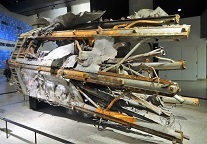 Approximately 360 feet tall this began broadcasting television signals in 1980. Transmission ceased shortly after the tower was hit by Flight 11. Part of the display is an Elevator motor. 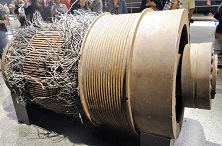 Also on display are pieces of steel, one which was once part of the north façade of the North Tower and was located at the point of impact where flight 11 pierced the building between the 93rd and 99th floors tearing a gash in the building more than 150 feet wide. Another is the folded column of the South Tower. This was between the 30 and 33 floors. Due to the extreme stresses, three of its four welds split open causing it to fold over onto itself. 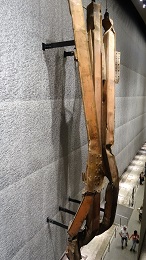 The North Tower rose more than a quarter of a mile into the sky, supported by 84 steel columns anchored 70 feet below ground. These columns which were cut off during the clean-up operations are viewed by the victim’s family members as defining the ground where their loved ones had been killed. The remains of these rectangular box columns can be seen around the building. Of hollow centre construction, they provided structural support for the Twin Towers and provided their distinctive facades. At the end of the recovery period, these were cut off just above ground level.  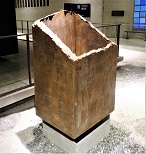 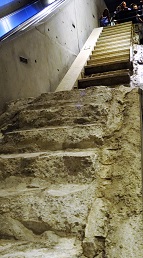 Another part of the building which can be seen is the Vesey Street Stairs which has become known as the Survivors Stairs, as they provided an exit that allowed people to escape even after the fall of the South Tower and the damage done to the stairs can be seen. One of the major areas of interest is the Foundation Hall, this is located at the foundation level of the Museum and contains a portion of the original slurry wall and the last column. This is viewed initially from the West Overlook as one progresses into the Museum. The Slurry Wall was required due to the proximity of the Hudson River. The river presented a significant challenge to the planners of the World Trade Centre during construction. Before excavation and construction could begin, it was necessary to find a way to prevent river water from seeping into or flooding the site. This was done by building a retaining wall, known as the slurry wall. Despite fears that it might be breached on 9/11, whereby worsening the impact of the attack, the wall held, a portion of the original wall has been preserved. As the recovery of the World Trade Centre site neared completion, one piece of steel was chosen to mark the occasion symbolically. 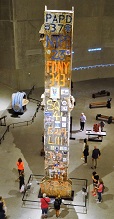 This was designated the Last Column and was removed from the site in a solemn ceremony held on May 30, 2002. In the weeks that preceded its departure, recovery workers, first responders, volunteers, and victims’ relatives signed the column and affixed to it memorial messages, photographs, and other tributes. Moving from the Foundation Hall, which contains a number of other exhibits, is a sign which says: “No Day Shall Erase You from the Memory of Time”. This is a 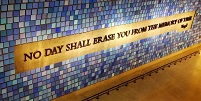 quotation taken from Book IX of The Aeneid by Virgil. quotation taken from Book IX of The Aeneid by Virgil. The blue squares are taken from the colours of nearly 3,000 depictions of the colour of the sky as depicted in watercolors produced by people recalling the colour of the sky on 9/11. Moving on from there is the Memorial Hall with the photographs of those killed in the attack and the Flag of Remembrance. This was conceived in the immediate aftermath of the 9/11 attack. It consists of the photographs of the victims transferred to fabric and sewn together to form the flag. There is also a room displaying the photographs of many of those who were killed. 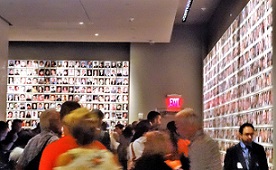 Outside of the museum stands a memorial to those killed as shown in the main photo at the top of the page. Around its sides are the names of those who died. Following 9/11 the United States was determined to find the top personnel of the al-Qaeda network. This led to the hunt for Osama bin Laden, and on May 2, 2011, Osama bin Laden was killed in a raid on his complex in Pakistan by a team of US Navy Seals. The whole complex of the museum and memorial is extremely well done, and a very moving place to visit. To see more photographs and take a virtual tour of the site click on the photoshow below. Visit Official Website |
|
|
|
|
|||
All Photographs were taken by and are copyright of Ron Gatepain
| Site Map |
